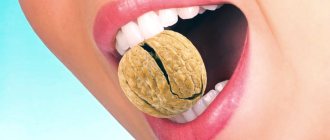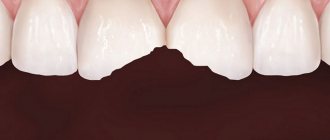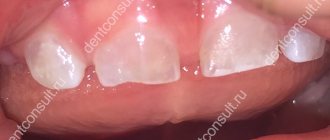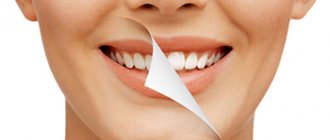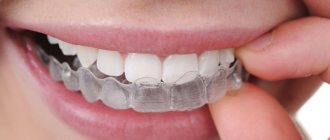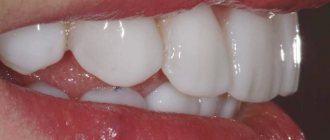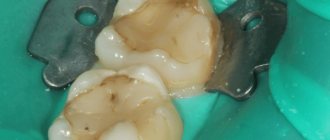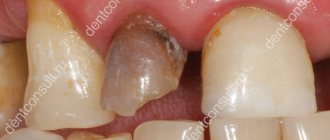Just some 10-15 years ago, it was simply proposed to remove a tooth broken at the root and install a prosthetic bridge in its place. There were either no other options, or they were inaccessible to ordinary people. The procedure itself usually turned out to be painful and lengthy: it involved grinding down adjacent teeth, removing nerves (depulping) and installing crowns, under which the teeth began to quickly deteriorate.
A tooth has broken at the root - what to do?
As a result, a person who once had the temerity to break a tooth became a regular patient in the dental office. Fortunately, today medicine can offer more effective ways to solve this problem.
Tooth fracture: definition, causes
A tooth root fracture is a significant violation of the integrity of layers of hard dental tissues, including enamel, dentin, and pulp. Such damage is typical mainly for the upper frontal incisors.
Broken tooth at the root
The most common cause of fractures is trauma. At risk are athletes (boxers, wrestlers, hockey players, extreme sports athletes, etc.), stuntmen and representatives of other dangerous professions, and children. Individual cases of fracture due to the unprofessionalism of doctors cannot be excluded, for example, when the size of the holes in the pins is incorrectly selected. Sometimes during the process of tooth extraction, the dentist may miscalculate the effort and accidentally damage the adjacent tooth with a metal instrument.
Athletes are at risk
In people with weakened enamel or advanced caries, a tooth may break off while eating solid foods. Finally, the cause may be a congenital abnormality of the jaw structure, in which the load on the dentition is distributed unevenly.
Treatment of small chips
Chips on the front teeth can form for various reasons:
- Increased load on the incisors when biting off hard foods.
- Injuries, mechanical shocks.
- Lack of calcium or nutrients.
- Dental diseases that thin or destroy tooth enamel.
With small chips, most often only the hard enamel is damaged, while the tooth pulp remains intact. This is the simplest situation. To solve the problem, aesthetic dentistry methods are used:
- Restoration with filling material. The dentist selects a composite that matches the shade and transparency of natural enamel. The filling material is then applied to the tooth to restore its shape. The advantage of the filling is its low price. We use modern materials, so the restoration lasts a long time. But even high-quality composites deteriorate over time. In addition, they tend to absorb dyes. Therefore, the filling changes color over time and becomes noticeable.
- Restoration with veneers. The veneer completely covers the surface of the tooth. It covers all small defects. Installing veneers is not always justified, as this is a more expensive option compared to a filling. We recommend using it if the beauty of your smile is important to you.
Dentistry for those who love to smile
+7
Make an appointment
First aid for a fracture
If an accident occurs before your eyes, you should make sure that the victim has no other injuries or a threat to life and only then focus on the tooth. Next, you should take it to the dentist as quickly as possible, having first tried to exclude infection and relieve pain:
- if there is bleeding, rinse your mouth with water, apply a piece of cotton wool or bandage to the injury site and press firmly - pressure will help stop the bleeding;
- for severe pain, give analgesics or NSAIDs, apply a cold compress (not ice);
- If you suspect a jaw injury, secure it with a bandage.
Cold compress
Chamomile infusion effectively soothes and disinfects open pulp; it is good if this remedy is at hand at the right time. Try to find the tooth or its fragments and bring it to the dentist, this will make it easier to assess the condition of the dental tissues and decide on the method of treatment.
Important! To avoid infection, perform all manipulations with clean hands.
Chamomile decoction
The most basic and obvious sign of such injuries is pain in a broken tooth, sometimes very severe, especially when trying to open or close the jaw. Fractures are also characterized by loosening of adjacent teeth, speech impairment, and bleeding gums. When the upper enamel layer is damaged, the pain is much less than when the deep tissues (pulp, dentin, root) are affected. Sometimes (this is extremely rare) a broken tooth may not hurt at all, but even in this case, seeing a doctor is necessary.
Broken tooth pain
Peculiarities
Doctors distinguish three stages of tooth decay: minor, partial and complete. Based on the amount of remaining living tissue, the dentist chooses the method and material for restoration. In some cases, it is enough to fill a small chip with a composite or partially build it up with appropriate materials to give it a natural color and shape. If the tooth is completely destroyed, the question of making a prosthesis arises. In this case, therapeutic treatment is pointless, and a prosthetist dentist is involved in the process.
Diagnosis of a fracture
In the dental office, the doctor, first of all, takes measures to relieve pain, then conducts a thorough visual examination to determine the severity of the damage. Its main task is to eliminate the likelihood of complications, such as:
- tissue necrosis, the symptoms of which are enamel staining and swelling;
- penetration of blood from damaged tissues into the internal cavity of the tooth;
- dislocation of adjacent teeth.
For a more accurate diagnosis, an x-ray is taken, which shows the direction of the fracture, the presence or absence of displacement, the condition of the root, and damage to the nerve endings.
- How long does it take for drugs to leave the body?
At the dentist
On a note! The final diagnosis is made only after analyzing the X-ray data.
To study the smallest details of the condition of the dental system, an orthopantogram (panoramic X-ray examination) or electroodontometry (allows you to determine the viability of the pulp in a deep fracture) can be prescribed.
Example of an orthopantomogram
Diagnostic measures
If the tooth has broken off to the gum line, the dentist will conduct an examination. He is studying:
- whether the surrounding areas are damaged;
- are there necrotic areas?
- whether blood got into the dental cavity;
- what condition are the roots in?
To clarify the situation completely, the patient is asked to undergo an x-ray. From the image you can understand whether the roots have shifted, whether the nerve fibers are damaged, and what condition the remaining solid structures are in.
Recovery methods
Qualified dentists, who have a wide range of modern technologies, strive to save the patient’s tooth in any situation. If the root has received minor damage or remains intact, there is always a chance of restoration of the dental unit.
Dental restoration methods
Restoration methods are divided into two large categories - with and without root removal. The choice of technology depends on:
- general condition of the damaged tooth;
- square hemp;
- the presence or absence of an inflammatory process at the root;
- volume of hard tissues;
- gum conditions;
- the presence of chronic diseases in the patient.
If caries, inflammation in the root canals, or dentin rot are detected, the remains of the stump are removed. The unsatisfactory condition of the external tissues inevitably leads to damage to the internal segment of the tooth located in the gum. Softened fragments of dental tissue, damaged by caries and injured, crumble easily. It makes no sense to leave such problematic roots and use them as the basis for recreating a tooth; they must be removed.
Often, the removal procedure is complicated by the incorrect position of the root (crooked, horizontal) or the small size of the stump with the impossibility of grasping it with surgical forceps.
Prepared tooth stump for restoration
The process of removing the root of a broken tooth includes:
- opening of the gums;
- removal of remaining hard tissue. The treatment is carried out using a gentle method using ultrasound (trauma is reduced, the recovery period after the procedure is shortened);
- dividing the root into parts in complex clinical cases. Such an operation may be accompanied by complications (in particular, alveolitis - post-traumatic infection and inflammation of the tooth socket), and long-term rehabilitation.
Tooth root fragments. The fracture line is deep under the gum
THE RECEPTION IS HOSTED BY:
MNATSAKANYAN LAURA GRIGORIEVNAComprehensive professional cleaning of the oral cavity, treatment of caries and its complications, professional teeth whitening, aesthetic restoration of teeth, microprosthetics (veneers, onlays), dental prosthetics, implant prosthetics |
| What to do if you break a tooth? Is it possible to restore a broken molar or chipped front tooth? At the Cervantes clinic, where advanced technologies and modern materials are used to restore teeth, you can! | What to do if you break a tooth? Is it possible to restore a broken molar or chipped front tooth? At the Cervantes clinic, where advanced technologies and modern materials are used to restore teeth, you can! |
Restoration of a dental unit with a removed root
Modern dentistry has two ways to replace a tooth in place of an extracted root - implantation and prosthetics.
Table. Modern methods of replacing a tooth at the site of the extracted root.
| Name, photo | Short description |
| Implantation | The process begins with the implantation of a titanium pin into the gum, which is gradually fixed and overgrown with gum tissue. After a certain time, an abutment is put on it - an imitation of a tooth, and then a crown of the required texture and shade, making the artificial tooth almost impossible to distinguish from the “native” one. Young patients can undergo rapid implantation (in one day). If treated with care, the service life of a restored tooth is 10 years. Implants from leading foreign manufacturers are provided with a lifetime warranty. |
| Bridges | The technology we mentioned at the beginning of the article has come a long way in recent years. Now, instead of radical turning, methods are used using plates attached to the back walls of supporting teeth (adhesive bridges), special micro-locks and other more gentle and effective methods. Removable bridges on crowns are fixed according to the telescopic principle (one crown is fixed to the tooth, the other is put on the first one along with the prosthesis). This method is considered the most reliable. |
- How to deal with unpleasant odors in the home of a seriously ill person
Separately, it is worth highlighting replantation - an exclusive method of restoration by returning the original tooth to the socket. Such operations are performed quite rarely, only when a newly knocked out tooth is brought to the dentist.
Replantation of teeth
Tooth restoration with preserved root
The possibility of restoring a tooth without radical measures appears in the following cases:
- in the absence of an inflammatory process and preservation of root canal tissues;
- with a stump size of at least 3 mm and a thickness of the remaining tooth walls of at least 1 mm.
If the tooth fragment is almost invisible from under the gum, restoration cannot be performed.
Restored a missing tooth with an implant
Restoration technologies with preserved root:
- formation of an anatomical structure based on the stump using composite filling materials coated with a crown;
- restoration by implantation of a fiberglass pin. The pin is used as a rod to more firmly attach a new tooth formed from filling material and a crown. The technology is widely used in cases where the amount of preserved external tissue is minimal;
How to install fiberglass pins
- a stump inlay coated with a crown is an innovative method of microprosthetics. In the dental office, an inlay is made from high-quality non-toxic materials with biological inertness (gold, platinum, cobalt, nickel, zirconium) and embedded deep into the root canal. Teeth restored using this technology are in no way inferior to natural ones in strength and retain their functions for 10 years or more.
Stump inlays
Prevention of tooth fracture
Athletes and stunt performers can only be given one piece of advice - use a mouthguard, this will reduce the risk of injury.
Mouth guards are the key to health
General recommendations for maintaining strong and healthy teeth:
- take good care of your teeth, gums, and tongue;
- use high-quality certified toothpaste or gel with therapeutic and prophylactic additives to strengthen the dentition;
- take vitamin complexes for gums and teeth with dietary supplements and useful minerals;
- Eat a healthy, balanced diet. There should be a sufficient amount of fresh vegetables, fruits, cottage cheese, fish, and hard cheese on your table - this will help maintain the health of the soft and hard tissues of your teeth. Try to eat less flour, sweets, too hot and cold, salty, as well as foods containing preservatives, dyes and other “chemicals”;
Products good for teeth
- Maintain a balance of solid and liquid foods. Both excess and lack of chewing load are equally harmful to teeth;
- Seek medical help in a timely manner for infectious and chronic diseases, monitor the normal functioning of the gastrointestinal tract and metabolism. The consequences of malfunctions in the functions of internal organs cannot be eliminated with the help of expensive paste or repeated hygiene procedures;
- take vitamin complexes for gums and teeth with dietary supplements and useful minerals;
Vitamins for teeth and gums
- try to give up cigarettes, excessive drinking and other bad habits;
- If you have any problems with your teeth or gum tissue, consult your doctor. Fragility of dentin and inflammation of the roots are the causes of tooth decay;
- make it a rule to visit the dentist once every six months for a routine examination, even if nothing bothers you.
Visit the dentist every six months
Don't forget about the financial side of the issue. Dental augmentation is far from a cheap procedure, and the cost of implants is even higher. Preventing a problem is always easier than eliminating its consequences.
